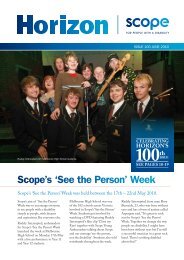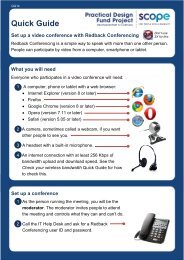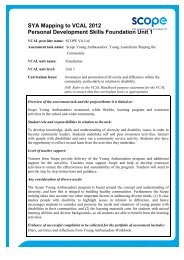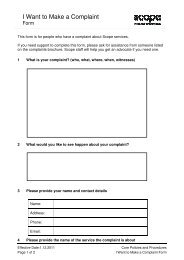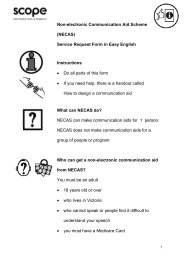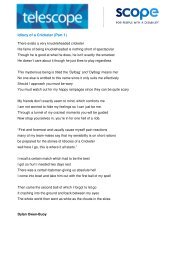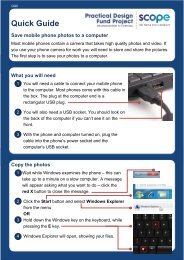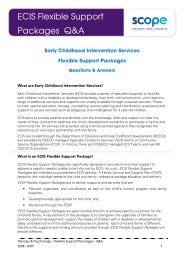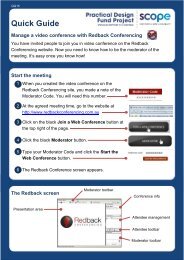Positive behaviour support Getting it right from the start
Positive behaviour support Getting it right from the start
Positive behaviour support Getting it right from the start
Create successful ePaper yourself
Turn your PDF publications into a flip-book with our unique Google optimized e-Paper software.
50 <strong>Pos<strong>it</strong>ive</strong> <strong>behaviour</strong> <strong>support</strong>: <strong>Getting</strong> <strong>it</strong> <strong>right</strong> <strong>from</strong> <strong>the</strong> <strong>start</strong> - Facil<strong>it</strong>ators reference manual<br />
PowerPoint 71<br />
*<br />
Augmentative and alternative communication can be divided into two groups:<br />
UN-AIDED AAC options<br />
(Requires no equipment)<br />
• Crying<br />
• Self-injury<br />
• Aggression<br />
• Vocalisations<br />
• Intonation<br />
• Facial expression<br />
• Touch<br />
• Eye gaze<br />
• Gesture, pointing<br />
• Manual signs eg: AUSLAN, key word signing<br />
• Speech<br />
• Individualised communicative <strong>behaviour</strong>s<br />
AIDED options<br />
(Requires equipment)<br />
• Object symbols<br />
• Partial objects<br />
• Raised symbols<br />
• Logos<br />
• Photographs<br />
• Line drawings Communication symbols, 13 Compic 14<br />
• Wr<strong>it</strong>ten word<br />
• SMS text messaging<br />
Useful AAC strategies for unintentional and intentional communicators 15<br />
Unintentional (non-symbolic)<br />
‘All about me’ book<br />
Communication passports<br />
Personal communication dictionary<br />
Activ<strong>it</strong>y sequence schedule using object symbols<br />
Multi-sensory environments<br />
Touch cues<br />
Intentional symbolic (symbolic)<br />
Chat books<br />
Commun<strong>it</strong>y request cards<br />
‘Who’s here today’ board<br />
Talking mat<br />
Activ<strong>it</strong>y sequence schedule using photographs and<br />
line drawings<br />
Social stories<br />
Feelings board<br />
What symbols can I use w<strong>it</strong>h <strong>the</strong> person?<br />
‘A symbol (visual cue) is a device or action that can be used to represent something else<br />
because <strong>it</strong> has qual<strong>it</strong>ies that can be associated w<strong>it</strong>h <strong>the</strong> original device or action. These symbols<br />
can represent places, people, activ<strong>it</strong>ies, feelings and objects’. (Bloom 1997)<br />
There are many different types of symbols we all use throughout our daily life. Not all people<br />
w<strong>it</strong>h complex communication needs will be able to interpret, understand and use symbols.<br />
13. Picture Communication Symbols © 1981-2007 Mayer-Johnson<br />
14. COMPIC© Communication Resource Centre, SCOPE, Victoria, Australia.<br />
15. For more information refer to <strong>the</strong> interAACtion manual (2004) InterAACtion© Strategies for Intentional and<br />
Unintentional Communicators. InterAACtion Copy<strong>right</strong> of CRC Bloomberg K, West, D & Johnson, H (2004),



